
Why and How Does the Skin Age?
Yes, aging is just part of the cycle of life – there’s no escaping it. But when we go one level deeper, we can better examine the two factors that impact the aging of skin and work to slow, and in some cases reverse the process.
The factors I’m referring to are intrinsic and extrinsic. Intrinsic refers the cycle of life I just mentioned. It is internal aging or biological aging that occurs with the passing of time. Extrinsic is external aging. It is the natural process of biological aging impacted by exterior elements like sun exposure, air pollution, smoking, lifestyle, cosmetics, lack of care and other allergens – all things we have some control over.
Be sure to educate clients on these aging elements, not only on what to avoid, but also how to counteract the effects of the unavoidable factors.
Environment
Our environment can have a serious impact on our skin’s aging. Exposure to extreme weather conditions – hot, cold, dry, and wind – for long periods of time can dehydrate the skin, zapping it of its moisture barrier and making skin appear prematurely aged.
Pollution – car exhaust fumes, smog, particulates in the air – is also a culprit of aging. It causes free-radical damage, which breaks down collagen and elastin fibers, thus aging the skin. Contaminates in the air can also impact moisture levels, causing dehydration and lack of oxygen to the skin.
Lifestyle
Lifestyle choices also significantly dictate how our skin ages. This includes sleeping patterns (inadequate sleep ages the skin), insufficient fluid intake, and poor nutrition can all have a destructive impact on the skin. The foods we eat can either the support the efforts of our skin care regimens or detract from them. See the blog post on “Food and Its Impact on Skin.
Smoking (I can’t stress this enough) is a big free-radical producer. It actually affects intrinsic (biological) and extrinsic aging. It is not only toxic to the skin, but it also dehydrates the skin and causes deep lines to form around the upper lip.
Sun Exposure
Last, but not least – in fact this is the most important – is sun exposure. It’s no secret that excess sun exposure is responsible for 90 percent of aging. It is the most damaging of all extrinsic factors. UVA and UVB rays absolutely destroy the skin.
Sun overexposure strips skin tissue of all moisture and hydration. The rays penetrate the dermis and negatively affect the skin at the cellular level causing long-term damage. It also depletes the nutrients in the skin, which over time compromises the skin’s ability to regenerate. Dead cells build up on the surface and the production of new skin cells decreases significantly, which results in aging.
So what can we do to slow or reverse the aging process? A lot, there is so much we have to offer in the aesthetic field to literally take years off one’s skin. For one, start with a skin peel – this will erase years in just one treatment. And now is the perfect time of year to get a skin peel. For long-term affects daily applications of age-renewal serums like Peptide 38 will eliminate the unwanted wrinkles. The key is to protect the skin and counteract the damage with antioxidants. Protect with a good physical block like zinc, using Daytime Defense, and support healthy cell development with antioxidants like superoxide dismutase, plant-derived antioxidants, resveratrol (wine extracts), grape seed extracts, D-alpha tocopherol, L-ascorbic acid, and beta carotene.
This is especially important as we age since our ability to repair damage from free-radicals decreases. Consider sending clients home with a tip sheet on elemental agers and a good at-home regimen to keep aging at bay.
Do you have a re-youth success story? How did you help your client?
For more on the importance of antioxidants, see the “Are Antioxidants Truly Important to Skin Health?” blog post.
